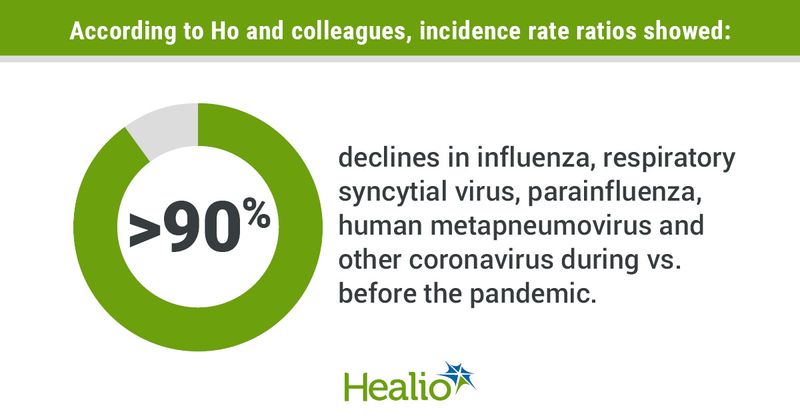Reduction in influenza, RSV during COVID-19 pandemic linked to less asthma, COPD events
Key takeaways:
- The COVID-19 pandemic led to a reduced volume of cases for several respiratory viruses.
- Asthma, COPD and respiratory tract infection hospitalizations and ED visits also went down during this period.
Incidence rates for several respiratory viruses, including influenza and respiratory syncytial virus, declined during vs. before the COVID-19 pandemic, according to study results published in Thorax.
Further, fewer hospitalizations and ED visits related to asthma, COPD and respiratory tract infections took place during this period, according to researchers.

“This study confirmed associations between the COVID-19 pandemic, non-COVID-19 respiratory virus prevalence and health care utilization in a large population in Canada,” Terence Ho, MB, MSc, FRCPC, assistant professor of medicine at McMaster University, and colleagues wrote. “Closely examining health care utilization revealed a new, shared peak for asthma, COPD and respiratory tract infection, which is associated with the re-emergence of rhino/enterovirus.”
In a population-based retrospective study, Ho and colleagues evaluated how the COVID-19 pandemic impacted the frequency of respiratory viruses unrelated to COVID-19 and usage of health care for asthma, COPD and respiratory tract infections in Ontario, Canada.
To compare trends before and during the pandemic, researchers assessed weekly respiratory virus tests, ED visits and hospital admissions from 2015 to 2021.
Researchers plotted the percent positivity and observed vs. expected number of positive viral cases, and they estimated changes in these data as well as in hospitalization and ED visits through Poisson and binomial logistic regression models.
During the first year of the pandemic, incidence of influenza, respiratory syncytial virus, parainfluenza, human metapneumovirus and other coronaviruses dropped by more than 90% vs. before the pandemic.
Notably, the reduction in adenovirus and rhino/enterovirus cases was not as large as the above viruses, with a 77% (incidence rate ratio [IRR] = 0.23; 95% CI, 0.1-0.53) decline in adenovirus and a 48% (IRR = 0.52; 95% CI, 0.18-1.54) decline in rhino/enterovirus during vs. before COVID-19 became widespread.
Researchers also observed declines in ED visits and hospitalization for all three assessed respiratory conditions during the pandemic. The largest drop in these events between the two periods was found for respiratory tract infections, with an 85% decrease in both ED visits (IRR = 0.15; 95% CI, 0.1-0.22) and hospitalizations (IRR = 0.15; 95% CI, 0.09-0.24) when COVID-19 became widespread.
For asthma-related ED visits, the incidence rate ratio was 0.43 (95% CI, 0.37-0.48), signaling a 57% reduction when COVID-19 was prevalent. For hospitalizations pertaining to asthma, this rate was 0.39 (95% CI, 0.33-0.46), signaling a 61% reduction.
Similarly, ED visits and hospital admissions linked to COPD dropped by 63% (IRR =0.37; 95% CI 0.3-0.45) and 45% (IRR = 0.55; 95% CI 0.48-0.62) during vs. before the pandemic.
Notably, children aged 0 to 15 years had larger declines than adults aged 16 years and older in asthma-related ED visits (IRR = 0.25; 95% CI, 0.19-0.33 vs. IRR = 0.51; 95% CI, 0.46-0.57) and hospitalizations (IRR = 0.25; 95% CI, 0.17- 0.36 vs. 0.56; 95% CI, 0.5-0.61) and respiratory tract infection-related ED visits (IRR = 0.09; 95% CI, 0.05-0.15 vs. IRR = 0.2; 95% CI, 0.15-0.27) and hospitalizations (IRR = 0.09; 95% CI, 0.05-0.17 vs. IRR = 0.38; 95% CI, 0.32-0.45).
Researchers observed a rise in hospitalizations and ED visits for respiratory tract infections, asthma and COPD during October of the pandemic, which corresponds to the peak of rhino/enterovirus.
“This is the first study to demonstrate that during the pandemic, increased rhino/enterovirus prevalence, likely related to alleviation of public health measures, may have contributed to a ‘rebound’ of health care utilization due to asthma, COPD and respiratory tract infection,” Ho and colleagues wrote. “Going forward, non-COVID-19 respiratory virus patterns may be altered and lead to atypical peaks in respiratory-related health care utilization, which could have implications on the timing of vaccine administration, development of novel vaccines, hospital bed planning and public health policy.”

